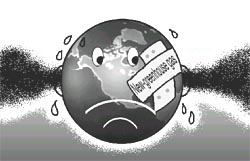Rising green heat
 a team of us and European scientists have identified a new greenhouse gas that traps heat more effectively than all other known greenhouse gases. Trifluoromethyl sulfur pentafluoride ( sf5 cf3 ) is a synthetic gas and is 18,000 times more effective in trapping atmospheric heat as compared to carbon dioxide, the most familiar greenhouse gas. T he gas absorbs solar energy and traps it, therefore, leading to global warming. Scientist discovered the gas in air samples taken over a distance of 34 kilometres in the stratosphere and also in air trapped under layers of Antarctic snow.
a team of us and European scientists have identified a new greenhouse gas that traps heat more effectively than all other known greenhouse gases. Trifluoromethyl sulfur pentafluoride ( sf5 cf3 ) is a synthetic gas and is 18,000 times more effective in trapping atmospheric heat as compared to carbon dioxide, the most familiar greenhouse gas. T he gas absorbs solar energy and traps it, therefore, leading to global warming. Scientist discovered the gas in air samples taken over a distance of 34 kilometres in the stratosphere and also in air trapped under layers of Antarctic snow.
Though the gas has been detected in the atmosphere in low concentrations, it still poses a problem because its density is rising quickly. "The discovery of sf5 cf3 is a surprise,' says Jim Elkins of the us National Oceanic and Atmospheric Administration's Climate Monitoring and Diagnostic Laboratory. According to him, the origin of the gas is still unknown. Some atmospheric chemist speculate that the gas is being secretly used by some industry or it is being utilised for manufacturing military equipment. They added that there is a possibility that it might be a unintentional byproduct of some manufacturing process. Gary Gard, chemistry professor at Portland State University in Oregon and a leading expert in the properties of compounds containing fluorine, said that sf5 cf3 had been synthesised more than 40 years ago but it has never been used except for research purposes.
Scattered molecules of the gas had started appearing in 1960s and they steadily increased, with concentrations growing at about six per cent a year. Scientific calculations show that about 4,000 tonnes of the gas have been released till now, with 270 tonnes emitted each year. "This has resulted in an overall concentration of only 0.12 parts per trillion in air,' says William Sturges, an atmospheric chemist at the University of East Anglia in Norwich, England. As sf5 cf3 is such a potent heat trapping gas, Sturges and his colleagues are hoping that the global community will try to find its source before it becomes a major environmental problem.
